The Magnificent Meenakshi Amman Temple of Madurai
Meenakshi Amman Temple – An architectural marvel dedicated to Goddess Parvathi
The Meenakshi Amman Temple is located in the center of Madurai. Not to mention, it happens to be the largest temple complex in the state of Tamilnadu. As per scholars the temple dates back to the first century AD.
In fact the Tamil poet and saint Thirugnanasambandar mentions the temple in early Tamil texts in the 6th century. The expansion of the temple continued over centuries as recent as in the 17th century.
Goddess Parvathi known as Meenakshi (fish eyed) is the principal deity here. Unlike other temples, people worship both Lord Shiva and his consort Goddess Parvathi here.
Ransacking and rebuilding of the temple:
The Ransacking:
Like many other temples of Southern India, Malik Kafur ransacked this temple in the 14th century. Malik Kafur was the commander of Allaudin Khilji’s army in the Delhi Sultanate. He defeated the Pandyan empire who indeed offered stiff resistance.
Despite the ransacking the sanctums of Lord Shiva and Parvathi remained intact! Malik Kafur however took along the entire treasury of the temple and wealth of Madurai to Delhi. Malik Kafur also plundered the temples of Srirangam, Belur and Halebidu and many more. The Meenakshi Amman temple lay in ruins for five decades under the rule of the Madurai sultanate.
The Rebuilding:
The Vijayanagara empire took control of Madurai after defeating the Madurai sultanate. They then removed the ruins and opened the temple for worship. Not only did they restore the temple but expand it as well in the 16th century. The first Nayak King of Madurai (Viswanatha Nayak) rebuilt the temple between the 16th – 17th century.
The Mythological Connection:
As per the legend, a king named Malayadwaja Pandya and his wife Kanchanamalai performed a fire ritual. Because the couple were childless they prayed to Lord Shiva. They requested Shiva to grant them a son. Their wish was then fulfilled. But to their shock and disappointment a girl with three breasts emerged from the fire.
For this reason, the royal couple expressed their concern about the girl’s appearance. Lord Shiva addressed their concern. He said the girl’s third breast would disappear when she meets her husband. The relieved couple thereupon named their daughter Meenakshi. This is because of her perfectly (fish) shaped eyes.
Meenakshi went onto be his successor and ruled Madurai. Not only did she capture the neighboring kingdoms but also the abode of Lord Indra! Meenakshi then set her eyes on Mount Kailash. It is then Lord Shiva also known as Sundareswarar made an appearance. On seeing Sundareswarar, Meenkashi’s third breast disappeared. Thus confirming she had met her husband. Sundareswarar and Meenakshi enter into a wedlock on returning to Madurai. Notably all the gods and goddesses attended the wedding.
Process followed even today:
There is a procession that takes place every evening. The priests carry the idol of Sundareswarar to the chamber of Meenakshi. The priests place the idol of Sundareswarar back in its original place in time for the morning prayer.
Every Friday, the priests place the idols of Meenakshi and Sundareswarar on a swing and gently push them.
As a matter of fact, every year during spring – the devotees congregate to celebrate the wedding ceremony. This wedding ceremony spans a period of 10 days. Millions throng the temple during this time to witness the celestial spectacle.
Architecture of the Temple:
The temple has fourteen gateway towers. Each tower has sculptures of gods, demons and animals. Besides towers, there are numerous pillared halls (mandapams) in this temple.
Like most temples in Southern India, the Meenakshi Amman temple is built in Dravidian style. The highlight of the temple being high gateway towers, mandapams, kalyani (water tank) and covered porches on temples.
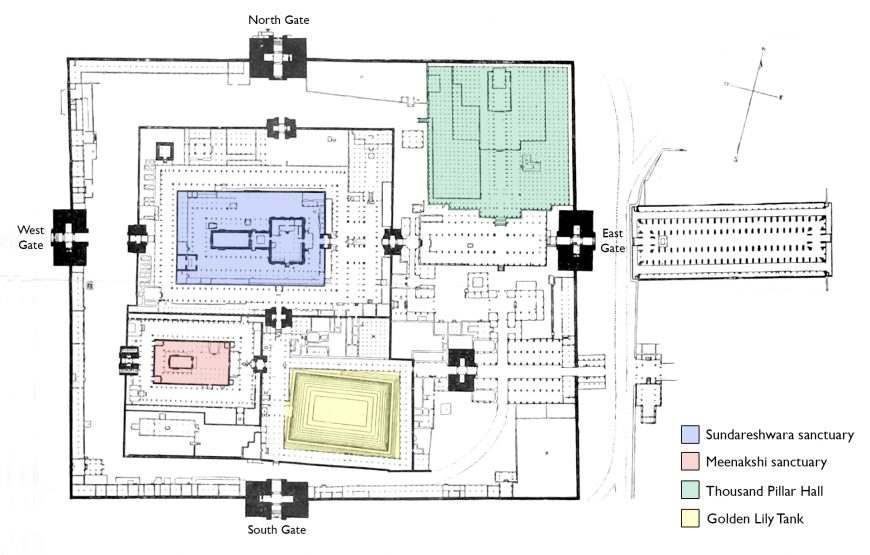
Gateway (Gopuram) towers:
Following is the segregation of gateway towers in Meenakshi Amman temple:
- Four – Nine tiered gopurams
- One – Seven tiered gopuram
- Five – Five tiered gopuram
- Two – Three tiered gopuram
- Two – Golden gopurams
Rajagopurams (Nine Tier Gopurams)
-
North Gopuram
- Krishnaveerappanaicker started the construction of the temple in 1564-1572. Eventually the family of Amaravathi Pudur Vayinagaram Nagappa Chetti completed it in 1878
- The tower is about 152 feet high with a base measuring 112 feet x 67 feet
- This tower is without a roof and has 404 carvings of mythological stories
-
South Gopuram
- Siramalai Sevanthi constructed the tower in 1559 AD
- The tower is about 161 feet high with a base measuring 108 feet x 67 feet
- It has numerous mythological sculptures on it (1511)
-
East Gopuram
- Pandian King Maravarman Sundarapandian constructed this tower
- The tower is about 154 feet high with a base measuring 111 feet x 66 feet
- It has many sculptures of the episodes from the puranas (1001)
-
West Gopuram
- King Parakrama Pandian constructed the tower between 1315-1347 AD
- The tower is about 155 feet high with a base measuring 101 feet x 64 feet
- The tower has numerous mythological characters (1124)
Gopurams dedicated to Sundareswarar (Lord Shiva):
-
Swami shrine Gopuram (3 tier)
- King Kulasekarapandian built this tower between 1168 – 1175 AD
- This is the most ancient tower amongst all the other temple towers
-
Swami Sannidhi Gopuram (5 tier)
- Vasuvappan constructed the tower in 1372
- Standing 66 feet high, it has a base area of 42 feet x 33 feet.
- It has 280 mythological figures on it.
-
Nadukkattu Gopuram (5 tier)
- Siramalai Sevanthi Murthy Chetti constructed the tower in 1559 AD
- Standing 69 feet high, it has a base area of 44 feet x 33 feet
- It has numerous mythological figures sculptured on it (112)
-
Swami Sannithi West Gopuram
- Mallappan constructed the tower in 1374 AD
- Standing 72 feet high, it has a base area of 48 feet x 31 feet
- It has many mythological figures on it (340)
-
Swami Sannithi North Gopuram (5 tier)
- Sevanthivellappa Chetti constructed the tower in 1560 AD
- There are 184 sculptures on it
Gopurams dedicated to Meenakshi (Goddess Parvathi):
-
Amman Sannithi Gopuram (3 tier)
- Anandathandava Nambi constructed this gopuram between 1227 and 1228.
- There are numerous mythological sculptures on it
-
Amman Sannithi West Gopuram (Kadahagopuram)
- Veerathummasi constructed this gopuram in 1570 AD
- Standing about 65 feet high, it has a base area of 50 feet x 28.6 feet
- There are 228 mythological figures on it.
-
Amman Sannithi Gopuram (Chittira)
- Kallathiappan Mudaliar constructed this gopuram in the year 1569 AD
- Standing 170 feet high, it has a base area of 78 feet x 38 feet. This is the tallest tower.
- There are 730 ascetic sculptures on it
Mandapams (Pillared Halls):
There are numerous mandapams in the temple. They earlier served as resting place for devotees and pilgrims.
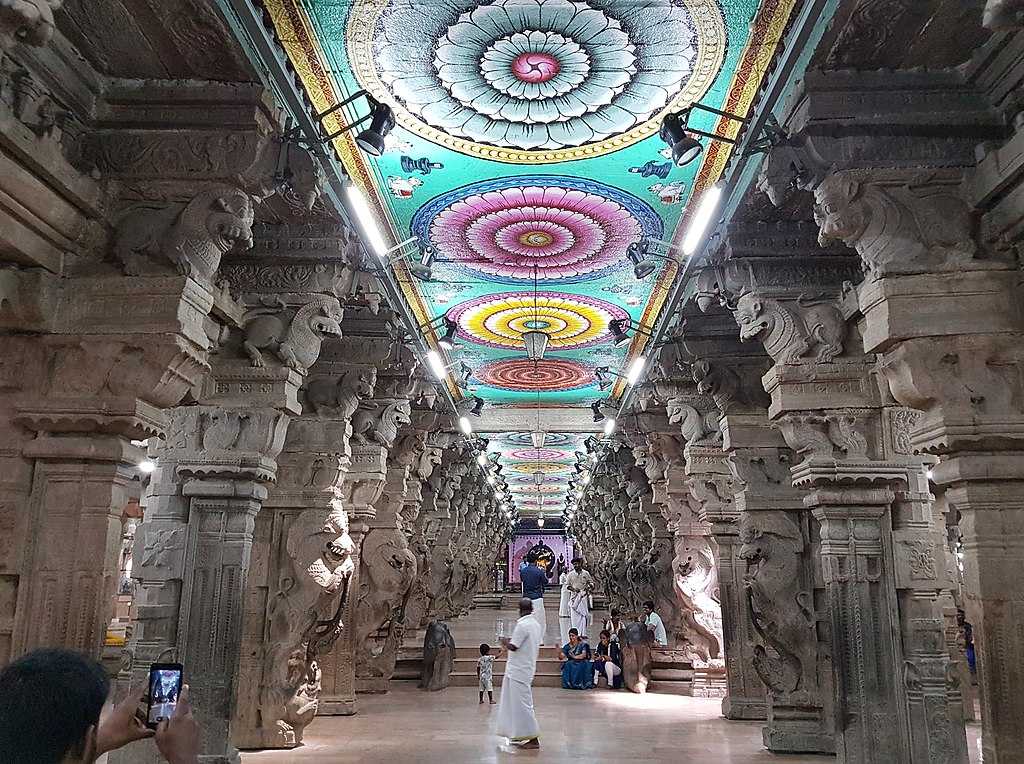
Some of the important mandapams are provided below:
-
Ayirakkal (1000 Pillars) Mandapam
- Ariyanatha Mudaliar built this mandapam in 1569 AD
- He served as general and chief minister under Viswanatha Nayakar – the founder of Nayakar dynasty
- This hall is supported by 985 pillars each sculpted magnificently with images of Yali
-
Kilikoondu (Parrot Cage) Mandapam
- King Muthu Veerappa Nayakar built this mandapam in 1623 AD
- This mandapam was built to house hundred of parrots kept in cages
- The parrots were tutored to say Meenakshi!
-
Ashta (8) Shakthi Mandapam
- King Thirumalai Nayakar’s two wives built this mandapam
- This mandapam has sculptures of eight (Ashta) goddesses and a lamp holder with 1008 lamps
- The hall is between the shrines of Sundareswarar and Meenakshi
-
Nayaka Mandapam
- King Tirumala Nayaka built this mandapam between 1622-1623 AD
- The hall is supported by 100 pillars and houses a Nataraja statue
In conclusion:
Meenakshi Amman temple is a fascinating temple visited by 15,000 people every day. Hence I recommend one to reserve a day to appreciate the grandeur of this temple.
Best time to visit Madurai
The winter months from October to March is the best times to visit Madurai.
How to reach Madurai ?
By Air:
The airport is located 10 kms from the main city and well connected from the major cities of India.
By Rail:
Direct trains are available to Madurai from many cities of India.
By Road:
Madurai is well connected by road.
For more such spiritual experiences in India, check out the places to visit for retirees and otherwise. In case culture is of interest, check out the places which cover the history of ancient India. And if history is your interest, check out some of the historical places in Tamilnadu and rest of India.
In case you are keen on traveling to southern India, you could take a look at the itinerary of Tamilnadu and add a couple of days to cover Madurai as a part of this itinerary.
India is not just about spirituality. There are many more facets to this ancient land – culture, mystery, history, nature, wildlife and so on. Check out the travel packages which exhibit the different facets of India.


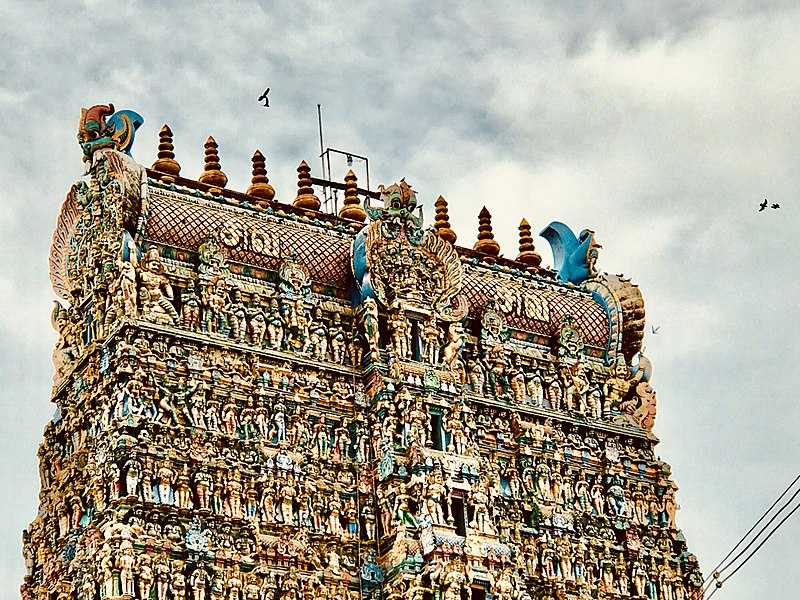
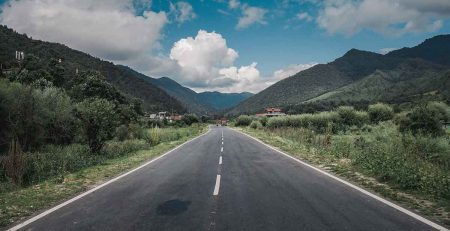

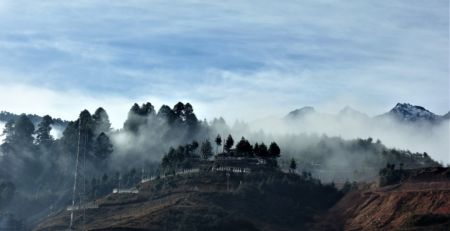


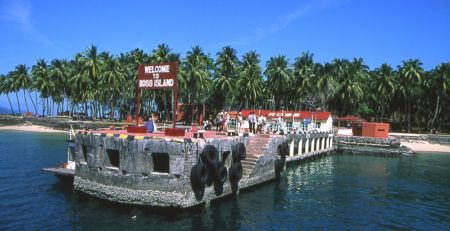
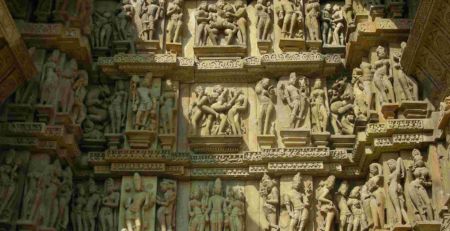


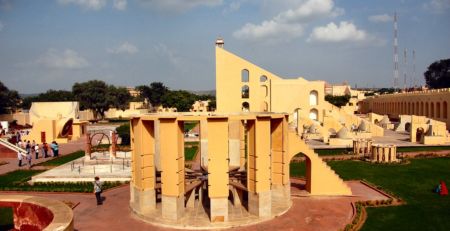
Comment (1)
great article
keep it up.